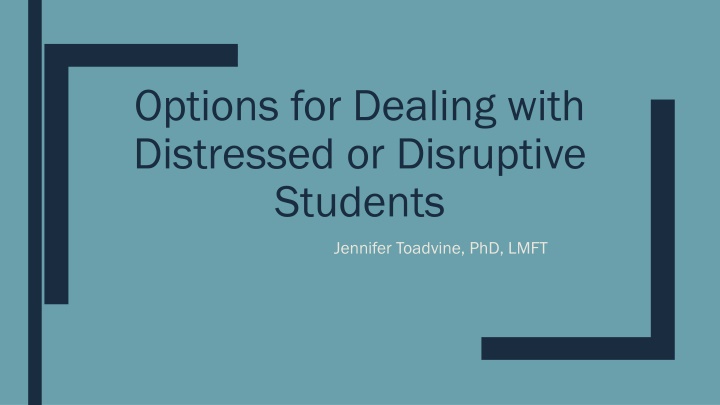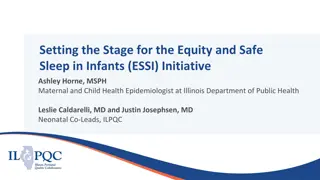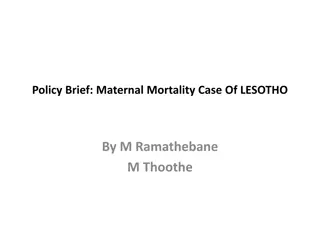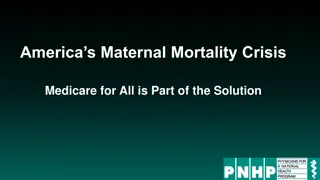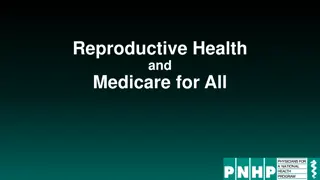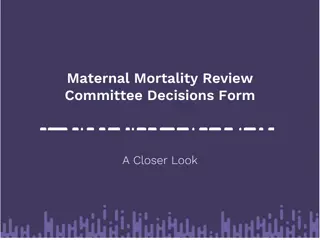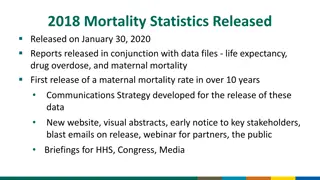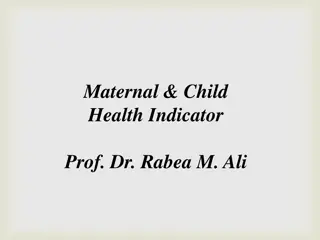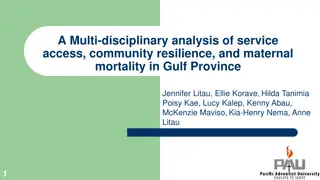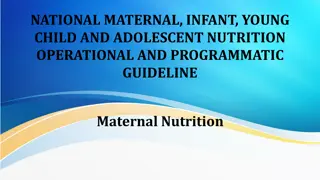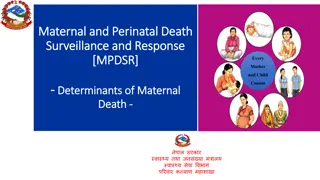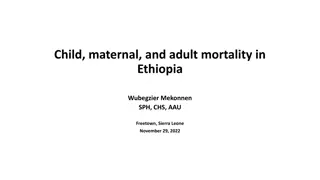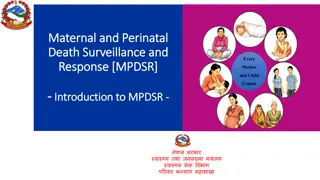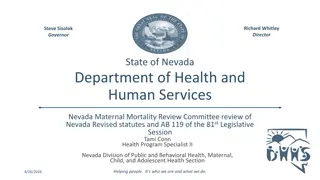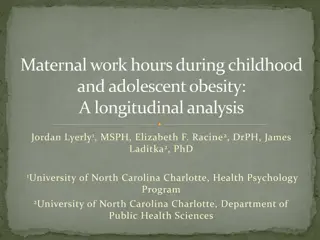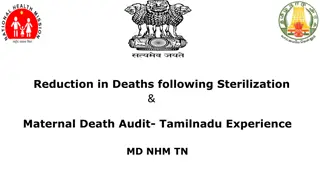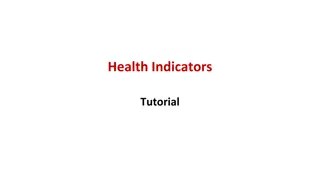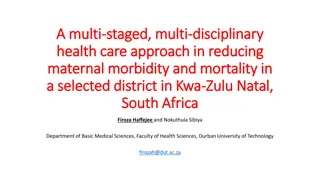Alarming Rise in Maternal Mortality Rates in Lesotho
Maternal mortality and neonatal mortality rates in Lesotho are at concerning levels, with societal norms and taboos hindering discussions on sexual and reproductive health. Despite challenges, progress has been made in advocating for safe abortion and providing support to vulnerable individuals.
Download Presentation

Please find below an Image/Link to download the presentation.
The content on the website is provided AS IS for your information and personal use only. It may not be sold, licensed, or shared on other websites without obtaining consent from the author.If you encounter any issues during the download, it is possible that the publisher has removed the file from their server.
You are allowed to download the files provided on this website for personal or commercial use, subject to the condition that they are used lawfully. All files are the property of their respective owners.
The content on the website is provided AS IS for your information and personal use only. It may not be sold, licensed, or shared on other websites without obtaining consent from the author.
E N D
Presentation Transcript
Options for Dealing with Distressed or Disruptive Students Jennifer Toadvine, PhD, LMFT
Young Adult/College Context Young Adult/College Context Pressures for Academic Performance Overwhelming Life Changes Financial Issues Limited Social Support Network-&/or Relationship Ruptures Losses/Traumas Identity Issues/Discrimination Lifestyle/Body Abuse Limits of Current Coping Skills/Strategies Development of Disorders in Adulthood
What Causes Student Disruptions What Causes Student Disruptions Besides Rudeness & Bad Behavior? Besides Rudeness & Bad Behavior? Psychosis Substance Use/Abuse Bipolar Mood Swings Traumatic Reactions (PTSD) Intense Anxiety/Panic Impulsivity Anger Control Problems Autism Spectrum Disorder Personality Disorders Depression Overwhelming Crises including academic, family pressure and financial Physical Illness
Suicide Suicide 2nd leading cause of death for college students 100-200 attempts for every completed suicide in young adult population Up to 16% of college students report seriously considering suicide in recent national survey- and up to 30% of CAPS students 2-5 Deaths by suicide each year at University Park Exposure to the pressures for performance and limited coping skills put students at risk
2014/2015 Penn State CAPS Primary Client 2014/2015 Penn State CAPS Primary Client Concerns Concerns Condition Condition Anxiety Stress Depression Academic Performance Family Relationship Problem Alcohol Self Esteem/ Confidence 23.7% Frequency Frequency 57.4% 53.0% 47.0% 34.2% 30.0% 25.2% 24.5% Interpersonal Functioning Sleep 22.9% 20.7%
Recognizing Distressed Recognizing Distressed Students Students How do you identify distressed or disruptive students? What behaviors feel disruptive in your class? What behaviors do your students engage in that trigger you? What does it feel like to recognize a distressed or disruptive student? How do you handle your own experiences?
Warning Signs Warning Signs Behavior or Appearance Behavior or Appearance Depressed mood or functioning Academic Academic Absences Hyperactive or pressured speech Failing grades Deterioration of hygiene/self care Withdrawal Dramatic weight loss or gain Excessive anxiety regarding performance Strange or bizarre behavior Disruptive behaviors Problems with boundaries/expectations Observable signs of injury
Counseling: Counseling: Customer Service Mentality Customer Service Mentality You want to help students. Services have a structure and things work best when students or other customers follow the rules, understand the services and have a sense of social protocol. But what if that s not the case and the situation challenges your usual approach?
Faculty and Staff Roles Faculty and Staff Roles Supportive Concerned Adult Knowledgeable Advisor about Penn State, academic success & life Voice of Emotional Intelligence Bridge to Mental Health First Aid and Evaluation Bridge to Safety and Limit Setting
Starting with us Starting with us - - What happens when we are caught off guard? when we are caught off guard? What happens Oh, No! Confusion Shock Fear Fight/Flight or Freeze Annoyance Overwhelmed Feel we hate students Indecisive or overly rigid
Distress & Disruption Distress & Disruption They may come together in the same person or event. It s important to think about how you would like to be treated in a similar situation (customer service) as well as workplace management for yourself and others. Addressing the distress w/ concern, listening support and referral. Addressing the disruption first from the student s perspective and then with helpful explanation, limit setting and consequences.
Show You Care Show You Care C Communicate Care and Concern Ask, Assess, and Affirm Reach for Resources and Refer Engage, Explain, and Eliminate Danger
Prevention/Intervention Prevention/Intervention Strategies Strategies Set Clear Expectations at outset- inc. Signage Have Positive, firm (not aggressive) energy. Speak calmly. Listen carefully. It sounds like you re very upset about that . Clarify: Here s what I can do for you. Check on options: We don t provide official audits but your advisor could do that . If a study group is loud, notice if others seem disturbed and offer an alternative space if available. Convey Concern for students even if they have engaged in questionable behavior.
Prevention/Intervention Prevention/Intervention Strategies Strategies Find a quiet private place for distressed students to wait for the next available staff person if that seems appropriate. Call a resource or walk with the student. Explain behavioral guidelines & consequences if needed. Our obvious isn t always obvious to the student. Refer internally or externally. Invite a colleague or supervisor to sit in. Get support- consult-call for help. For physical security/safety call Police 863-1111 or 911.
Progressive Engagement Progressive Engagement- - When students cross the When students cross the line line Paul Paul Joffe Joffe and Sam Cochran and Sam Cochran- - Big Ten Counseling Center Conference Big Ten Counseling Center Conference- - (2008) (2008) Find out what happened and why to the extent possible- Was it intentional or lack of awareness? Convey concern for the student even if they have engaged in questionable &/Or violent behavior Convey and explain behavioral expectations Convey consequences Offer help/referral if student needs support to avoid problem behaviors or to deal with violence from others Secure help and support for yourself Remember to consult & document Meet with the student again with progressive consequences for further episodes of concern
Scenarios to Practice You are passing back papers. You notice a student has placed a hunting knife on her desk. You ask her to put it away. She does. It s time to begin class. You notice a student standing in the back of the classroom. You ask the student to take his seat. He doesn t. You ask for an explanation. The students says, I m okay right here. He continues to stand throughout the class period. The next class the student returns. He assumes his seat. A student follows you to your office. He begins yelling because he doesn t like the grade he received on an assignment. He blocks your office door.
